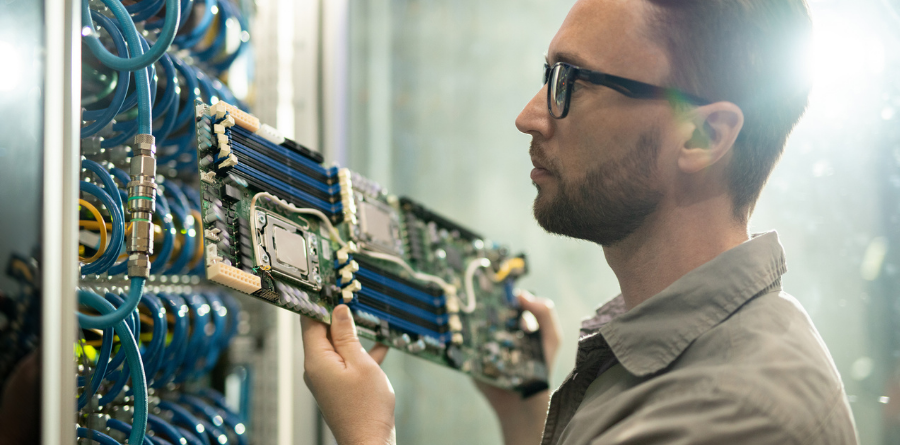
Colocation data center managers are under pressure to manage costs while simultaneously optimizing performance—two goals that are often at odds with each other.
As a result, there is a tendency for managers to maintain the status quo while all components are still working. But just because your hardware is technically functional, doesn’t mean there aren’t beneficial reasons to upgrade to new or more feature-rich equipment.
Things to Consider Before Upgrading Your Colocation Facility Hardware
To upgrade or not to upgrade is a tough choice when the hardware isn’t broken. There is a significant need to fully assess and understand what needs to be done before committing to replacing or updating your current RAM, hard disks, power supplies, data acquisition engines or other server hardware.
Here are a few factors to consider before diving into an upgrade:
Time
Upgrading your data center hardware is no small project. Does your staff have the time and expertise to work on the upgrade without impacting day-to-day operations?
Expense
Installing new or enhanced hardware is a major expense—even more so now, thanks to supply chain shortages. Will using the budget to update hardware that isn’t currently failing going to take money away from higher-need purchases?
Risk
Downtime is always a possibility during any repair, upgrade or other significant maintenance event. Do you have a plan in place for redundancy and recovery?
Necessity
If you are basing the decision to upgrade your colocation data center hardware on a generally accepted “life span,” you may want to dig deeper to determine whether the upgrade is really necessary. Is performance significantly degraded? Are any components getting close to their end-of-life date? Would it be cheaper to replace the hardware than to repair and maintain it?
Alternatives
Traditional, on-premises hardware is no longer the only option for colocation data centers. Before upgrading to the same infrastructure, look into cloud-based, modular and “green” alternatives.
Signs a Hardware Upgrade Is the Best Course of Action
Running through the checklist above is always good for due diligence’s sake. However, there are a few instances where upgrading your hardware is the obvious best or only way forward.
If your colocation data center is experiencing any of these hardware-related pain points, it’s time to start planning an upgrade:
The current hardware isn’t energy efficient.
Data centers consume 1 percent of the world’s electricity, which equates to billions of dollars annually. The volume of data being generated is skyrocketing, but data center components keep getting more and more energy efficient. Upgrading your hardware to a more efficient version could have a big impact on your facility’s power usage, and lower your organization’s carbon footprint.
Your servers are having latency and connectivity issues.
Latency problems are bad for business. If your facility’s connectivity is unreliable and causes performance issues for tenants, it’s definitely time for an upgrade. If gone unchecked, you risk losing them.
You plan to expand capacity in the near future.
Increasing demand for capacity without adding or upgrading your existing hardware is a service level agreement breach waiting to happen. If expansion is in your facility’s short-term growth plan, don’t wait to upgrade the infrastructure you need to support it.
You plan to expand into new markets.
As edge computing takes off, colocation data centers are adding access points in smaller secondary markets. Installing the most up-to-date hardware in these remote locations is key to mitigating latency issues for your tenants’ edge users and for those workers who migrated out of the urban core during COVID-19.
You’re running out of storage space.
By some estimates, the world stores more than 1,300 exabytes of data each day. Although data is digital, storing it requires physical space. If your storage needs are close to exceeding your data centers’ storage space, there is no question that a hardware upgrade is needed.
Ways Modular Colocation Data Centers Make Upgrading Hardware More Efficient and Cost Effective
Modular colocation data centers are built for change, which makes it easy to upgrade—and even refresh—hardware as needed.
Modular construction means the physical space is customizable both during the original build or after installation if your facility’s needs change. And there is no overprovisioning because you only pay for the storage and memory you need today, with the option to scale up or down later.
Want to learn more about maintaining high performance while growing capacity? Watch “3 Tips for Expanding Your Data Center Facility Without Breaking the Bank” for insight on cost-effective expansion in uncertain times.


![[Webinar] Discover how modular colocation is empowering organizations to better meet the needs of their customers while preparing for the future.](https://no-cache.hubspot.com/cta/default/2974487/33f29825-5f34-4efd-b690-42f5d75f17b7.png)

Comments